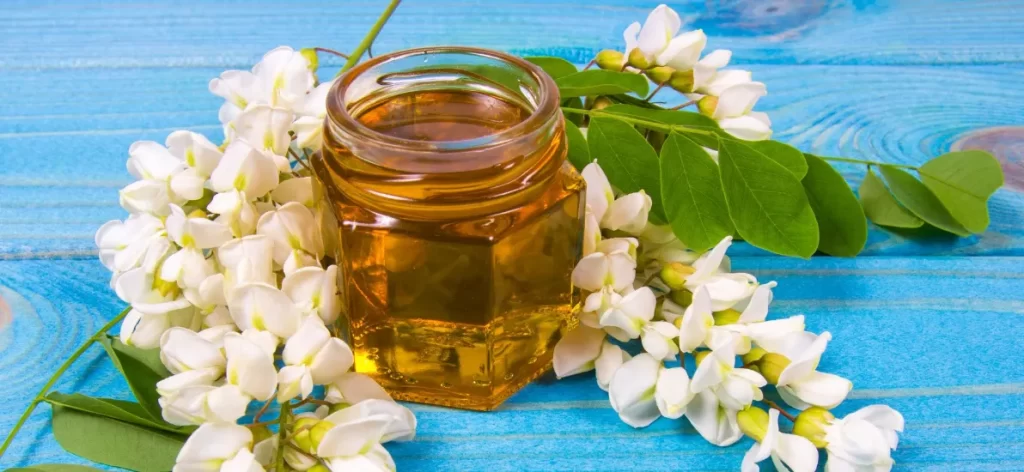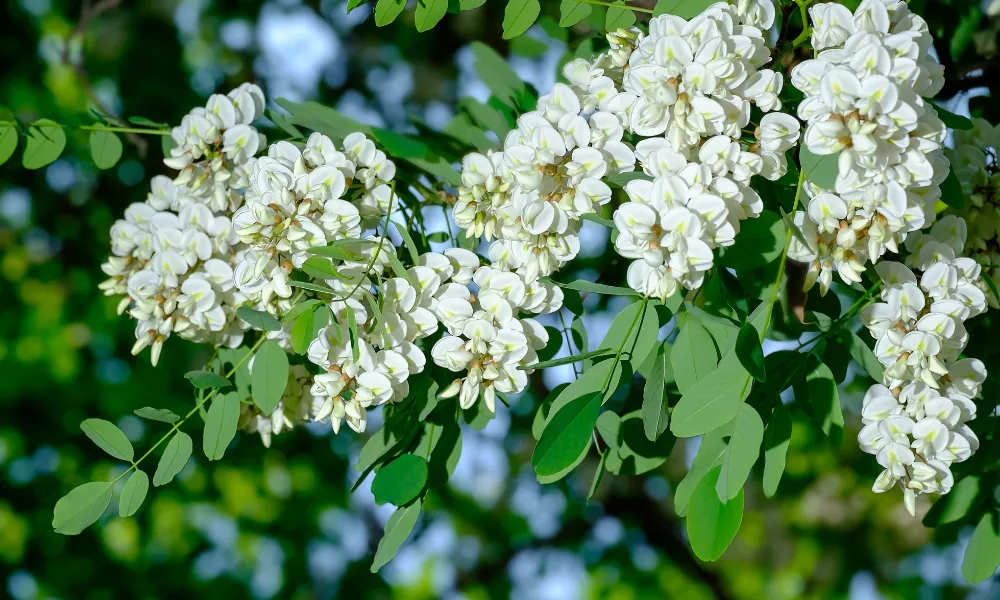I recently came across the fact that there are about 300 types of honey in the world. But everyone agrees that acacia honey is the tastiest and the healthiest.
Due to its characteristics, acacia honey is one of the most valued types of honey. As it is the sweetest, it is also a favorite among children.
In this article I will write about the origin and appearance of acacia, the appearance and composition of acacia honey, methods of consumption, and its medicinal properties…
The origin of acacia
Acacia is native to North America and is also called false acacia or in Latin Robinia pseudoacacia. It got its name from Robin, who was a gardener of Henry IV and Louis XIII in Paris. He first brought acacia from North America in 1600.
In 1601, the first acacia was planted in Paris. From there, thanks to its properties, it spread very quickly throughout Europe.
Initially, it was grown exclusively in parks and gardens, but later it became a very suitable species for afforestation of barren lands, sandstones and torrent areas.
Planted trees give much more nectar than that from the forest, because they get more sun. At the time of flowering, one beehive can produce up to 50 kg of this delicious honey.

What does acacia look like?
Acacia is a deciduous tree from the family Fabaceae. It inhabits dry and moderately humid terrains and likes sunny areas, especially forest edges. It comes as part of mixed forests, but also in pure acacia forests.
Acacia is a fast-growing tree that can grow more than a meter in height for the first 5 years. It grows up to 25 meters in height, and reaches its maximum height at about 40 years of age. There have been records of trees reaching up to 200 years of age.
Acacia has a branched root system. The shallow main root (up to 1.5 m deep) and the lateral root, which can be up to 20 m long, are well distinguished. The tree grows up to 90 cm in width.
The young bark is smooth and brown; the old bark becomes longitudinally furrowed. The side branches are easily breakable under the load of snow or strong winds. There are thorns on the branches. The leaves are oddly pinnately composed of 9 to 25 leaves. The ovoid leaves are entire with rounded bases and slightly incised tips
The white fragrant flowers that grow in clusters secrete a lot of nectar and attract bees. The acacia fruit is a flat, up to 11 cm long pod, with 4-10 kidney-shaped seeds.
It blooms from April to late May or even June. If you want to pick an acacia flower, then you should know that it should be picked just before opening and the leaf while it is still young.
Due to its lush flowering and fragrant flowers, it is grown as an ornamental tree in gardens, parks and tree lines.

When does acacia bear honey?
Acacia grazing begins in late April or early May and flowering lasts about 2 weeks. The flowering period of acacia is characterized by a pleasant scent that spreads all around the trees.
Unfortunately, there are often years when acacia does not bear honey. The reason for this is climate change and sudden changes in warm – cold weather as well as the occurrence of rainy weather during the flowering period. It takes a relatively warm spring to keep its buds from freezing.
Nectar secretion is favored by warm nights with plenty of morning dew, and the days should be moderately warm and windless. The optimum temperature for nectar secretion is between 20 and 25 ° C at a relative humidity of 70 to 90 percent. Honey bearing is damaged by fog, it is less damaged by colder winds, while warmer and drier winds burn the flower, so honey bearing can stop abruptly.
Lack of surface, capillary water in the soil is another cause of reduced yield of acacia honey. When there is not enough water in the soil, acacia, instead of bearing honey, turns to a different strategy. Its flowers emit a stronger scent which attracts other pollinators that are less demanding in terms of nectar than bees.
All these factors influence the fact that acacia fails in bearing honey more often than in previous years due to unstable weather conditions caused by climate change.
Composition and appearance of acacia honey
If you like the honey to be mild, with an extremely pleasant smell and taste, then choose acacia honey.
When it comes to the appearance of this type of honey, the color varies from yellow and gold, and during crystallization it even takes on a milky white shade.
Acacia honey is the lightest; it contains small amounts of pollen powder, so it can be eaten by people who are allergic to pollen.
Acacia flowers contain vitamin C, essential oil, sugar, resin and tannins, while the seeds contain about 38% protein, carbohydrates, vitamins A, BI, B2, B6 and C and magnesium, phosphorus, iron, zinc, potassium, sodium, calcium.
Compared to other honeys, it has the most fructose, which crystallizes slowly, so it remains in a liquid state for up to three years.
Acacia honey stays fresh for up to two years from the date of packaging; however, it is necessary to store it in a well-closed jar, protected from light sources, in the refrigerator or at room temperature.
Crystallization of acacia honey
The natural property of any honey is crystallization, so it is also a property of acacia honey. Crystallization occurs when glucose, one of the three sugars in honey, begins to separate into crystals, losing water.
Acacia honey contains more fruit than grape sugar, so the crystallization period is longer compared to other types of honey. It usually starts to crystallize after a year from the time of collecting, and sometimes that period can be longer.
It is returned from the crystallized to the liquid state by heating to a temperature of up to 40 degrees Celsius. By heating at that temperature, honey does not lose any of its useful ingredients because it is naturally consistent in the hive at that temperature.
Daily doses of acacia honey
In order to make the most of all the useful properties of acacia honey, it is recommended to use it early in the morning, before breakfast. Adults should consume a tablespoon of acacia honey, and children a coffee spoon. Honey can also be taken by stirring it in a cup of coffee or tea.
Normal daily amounts of honey are:
For adults: 60-100g, divided into 3-4 doses during the day;
For children: max up to 30g, divided into 3-4 parts.
Honey and products with honey are used by keeping them in the mouth as long as possible until they melt. Or they can be dissolved in lukewarm water and then drunk.
It is necessary to emphasize that the worst way to take honey, as well as products with honey, is when honey is swallowed and then cold water is drunk.
Acacia honey in honeycomb
When I was younger, chewing honey in a honeycomb was something special to me. Today, honey in the honeycomb is one of my son’s favorite treats.
If you have never chewed honey, you should. And you should offer it to your children.
Namely, such honey is the healthiest and best way to consume honey, because the honeycombs contain the remains of propolis and pollen.
You can really get healthy by chewing honey in a honeycomb. It helps with inflammation of the gums, oral cavity, throat and sinuses. Keeping honey in the mouth reduces the number of bad bacteria in the mouth, and with the departure of unwanted bacteria, inflammation is reduced.
How to store acacia honey?
Acacia honey, like other species, should be stored in a glass bottle, away from the sun. It can crystallize a few months after production, but as I already wrote, even after three years.
Some like it even more because it can be chewed. But if you are not a fan of crystallized honey, you just need to immerse it in warm water in order to return it to its liquid state.
Honey should be enjoyed, and with acacia honey you will stay healthy.
Acacia honey is highly valued all over the world. The reason for this is its characteristically mild taste and unique bright golden-yellow color.
Medicinal properties of acacia honey
Acacia honey is extremely medicinal and is one of the most prized types of honey.
Medicinal parts of acacia are the flower and bark, but while the tree is young. It is highly recommended that the bark, while young, be removed from the branches in May and September and dried in the sun.
The flowers can also be dried, the only difference being that they are dried in the shade. Acacia beans, after drying, can also be conserved, which further means that they can be used as vegetables. They contain 6% fat, 15% protein and 22% digestible carbohydrates.
Acacia honey is recommended primarily for children who have respiratory problems or asthma.
It is also useful in many ways when stomach problems in the form of cramps or diarrhea occur.
It calms the nervous system and eliminates the consequences of accumulated stress, and helps us treat insomnia because it enables healthy sleep.
Overall, it protects the body from bacteria, infections and viruses.
Researches have shown that acacia honey has a strong antibacterial effect and can extremely protect the skin from bacteria, thus preventing the development of acne and other skin problems.
Acacia honey, as a medicine, is very effective in treating colds and help the body recover from exhaustion. It is best to keep it out of the reach of light at room temperature.
Due to its specific smell, it increases appetite and compensates for lost energy in a short time. It also regulates the level of stomach acid, so it is recommended for those who have stomach problems.
It is characterized by a low glycemic index, so it is considered to be very good for diabetes.
If you suffer from some allergies, do not let that prevent you from taking acacia honey, it contains low levels of pollen and is not treated with pesticides and insecticides.
Although acacia is an excellent natural remedy, the important thing to remember is that only certain parts of acacia can be used for medicinal purposes.
Old bark, raw seeds and ripe leaves should not be used in any way because they contain a lot of phasin, robitine, robinin and robin. Otherwise, a large number of side effects can occur, such as weakness, depression, paleness, weak pulse, cold feet and hands, etc.

